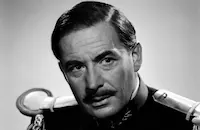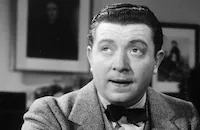The Velvet Touch

Brief Synopsis
Cast & Crew
John Gage
Rosalind Russell
Leo Genn
Claire Trevor
Sydney Greenstreet
Leon Ames
Film Details
Technical Specs

Synopsis
In the upstairs offices of the Dunning Theatre, Broadway star Valerie Stanton argues bitterly with her longtime producer and former lover, Gordon Dunning. Valerie declares her intention to marry architect Michael Morrell and end both her personal and professional relationship with Gordon, but the domineering producer refuses to part with her. When Gordon threatens to tell Michael ugly lies about her past and then grabs her, Valerie becomes frightened and hits him over the head with a statuette. Realizing that she has killed him, Valerie slips downstairs without being noticed. While Valerie says goodbye to the cast and crew of her latest hit comedy, co-star Marian Webster finds Gordon's dead body. Later, in her apartment, Valerie recalls the events leading up to Gordon's demise: On the way to an opening night party at Gordon's, Valerie and Gordon argue about her desire to star in a production of Hedda Gabler . Although Valerie, who has made her name in comedies, is confident that she can play the dramatic part, Gordon belittles her ambition. At the party, Valerie meets Michael, a witty Englishman, and feels instantly attracted to him. Later that night, Valerie resumes her quarrel with Gordon about Hedda Gabler . Then, over Gordon's objections, Valerie lunches with Michael the next day and soon falls in love with him. Determined to sever all ties with Gordon, Valerie asks Marian, who loves the producer despite having been dumped by him ten years before, for help. Although Marian despises Valerie, she agrees to use whatever influence she has on Gordon to distract him from the star. In a theater restaurant, Marian tries to rekindle Gordon's feelings for her, but he is too preoccupied with Valerie to respond. When Valerie comes to his table and invites him to her home the next evening for a "business" talk, he assumes that she is returning to him. Gordon then tells Broadway reporter Jeff Trent that Valerie is going to star in his next show, and the item appears in the newspaper the next morning. When Valerie sees the announcement, she storms into Gordon's office and demands that he issue a retraction. Gordon refuses, and the fatal argument begins. Back in her apartment, Valerie is informed of Gordon's death and is summoned to the theater. There Captain Danbury, a theater-loving police detective, questions the cast and crew about their activities the previous night. During the interrogation, Marian, who is in a shock-induced coma at the hospital, is implicated in the crime, while Valerie is barely questioned. Later, Danbury shows Valerie a love letter that Gordon had written to her just before his death, as well as a letter of rejection addressed to Marian. When Valerie then learns that Danbury has Gordon's diary, she becomes concerned, but the detective only uncovers more damning information about Marian. While Danbury is visiting her one day, Valerie insists that Marian is innocent and, describing her actual movements at the murder scene, playfully suggests that she is the killer. Danbury, however, dismisses her "confession" because she has offered no motive for the crime. Marian then regains consciousness and, guessing Valerie's guilt, denounces her as a heartless killer. Marian's harsh condemnation moves Valerie to seek out Danbury, but as she is about to confess, the detective receives a call informing him that Marian has committed suicide. Completely undone by the news, Valerie is unable to concentrate during rehearsals for Hedda Gabler and appears headed for a breakdown. On opening night, Danbury informs her that he is closing the case, but Valerie cannot let go of her guilt, especially after the devoted Michael tells her that he has known the truth about the murder all along. Just before the curtain rises, Valerie scribbles a confessional note to Danbury and places it in the velvet gloves she wore while striking Gordon. Relieved of her burden, Valerie gives a stunning performance, then, after taking her curtain calls, gives herself up to Danbury.

Director
John Gage
Cast

Rosalind Russell

Leo Genn

Claire Trevor

Sydney Greenstreet

Leon Ames

Frank Mchugh

Walter Kingsford
Dan Tobin

Lex Barker
Nydia Westman
Theresa Harris

Russell Hicks

Irving Bacon
Esther Howard
Harry Hayden
William Erwin

Martha Hyer

Steven Flagg
Louis Mason

James Flavin
Charles Mcavoy
Dan Foster

James Todd
Joyce Arling
Ida Schumaker
Phillip Barnes
Besse Wade
Jack Chefe
Pierre Barale
Barbara Smith
Jack Gargan
Mike Lally
Robert Malcolm
Lloyd Dawson
Tom Coleman
Eddie Hart

Bess Flowers
Marjorie Walker
Douglas D. Coppin
John Hilton
Carl Leviness
Dick Gordon
Olive Larkin
Monya Andre
Herbert Evans
Robert Riordan
Donald Wilmot
Bernice Firestine
Howard Keiser
Lorraine Comerford
Patty Lou Arden
June Lepre
Barry Norton
Boyd Cabeen
Bill Sheehan
Roger Creed
Kathleen Ellis
Dorothy Curtis
Katherine Lytle
Joe Bernard
Monte Montague
Miles Shepard
Bob Thom
Art Dupuis
Jim Drum
Ralph Montgomery
Al Munroe
Allen Ray
Bill Wallace
W. J. O'brien
Eddie Borden
Tex Swan
Sam Lufkin
Sam Ash
Major Sam Harris
Alfred Park
Albin Robeling
Jean Acker
Jane Allen
Lorraine Gale
Ethel Greenwood
Charmienne Harker
Grace Kenny
Helen Perissi
Catherine Price
Loretta Russell
Ed Ingram
Crew
C. Bakaleinikoff
Travis Banton
Frederick Brisson
Frederick Brisson
Henry Burton
Russell A. Cully
Edward Donahue
Edward Donahue
Ruby Felker
William E. Flannery
Leonard Gesa
Mort Greene
Roland Gross
Leigh Harline
Leigh Harline
Maxwell O. Henry
Jerry Hoffman
I. Hogan
Chandler House
Alex Kahle
Terry Kellum
William Mercer
Fred Phillips
Walter Reilly
Annabel Ross
Leo Rosten
Darrell Silvera
Richard Van Hessen
Joseph Walker
Maurice Yates

Videos
Movie Clip



Film Details
Technical Specs

Articles
The Velvet Touch
The Velvet Touch brings her back to her Broadway roots, in a way, and to the kind of career-woman roles in which she excelled before hitting it big as a snappy, street-smart comedienne. Valerie Stanton is a confidant sophisticate in the elegant world of New York celebrity, a woman who moves through society with the deft aplomb of someone used to playing the part offstage as well as on. (The film's title may refer to the gloves she always wears in public, part of the costume of the star persona.) But behind the façade of poised contentment is a frustrated career actress anxious to challenge herself with a demanding role, and a woman who is, perhaps for the first time, in love. Dunning, her possessive producer/director (and, we can infer, her one-time lover), refuses to release her professionally or personally. "I might even kill you, if I have to," he threatens in the ferocious argument that opens the film. In her fear and fury, Stanton grabs a statuette from his desk and lashes out with a blow to Dunning's head. He's dead and she flees, almost trancelike, from the scene of the crime, maintaining her poise until she finally arrives home. The film dissolves into flashback: the offer to play Hedda Gabler, the courtship of suave, continental architect Michael Morrell (British actor Leo Genn, whose charm and manner recalls Herbert Marshall), and her battle of wills with Dunning and rival actress Marian Webster (Claire Trevor), who plays a secondary role to her both onstage and off. The story snaps back to the present with the entrance of Sydney Greenstreet as Police Captain Danbury. As he follows the clues to another suspect, Stanton is wracked with guilt and responsibility.
The Velvet Touch was the first film made by Independent Artists, a production company that Russell created with her husband, producer Frederick Brisson. Jack Gage, the dialogue director on her previous films Sister Kenny (1946) and Mourning Becomes Electra (1947), made his directorial debut with the production and acquitted himself admirably, if not all that memorably. His staging is more theatrical than cinematic, appropriate perhaps for a film so steeped in the culture of Broadway but less effective in building tension or plumbing the depths of psychological torment. His strength is in the direction of actors. Russell made her fame with larger-than-life performances ("Sometimes what you have to do is almost claw your work onto film," she explained in a 1965 interview) but limits her flamboyance to the performances within the performance, and not just on stage. She plays the part of the Broadway star in the public theater until the worldly, cultured Morrell breaks her out of her comfortable role with his attentions and affections.
The film marked one of the final performances for Sydney Greenstreet, who brings a joyful heartiness to The Velvet Touch as the amiable but cunning police investigator. He cracks jokes about his girth by way of introduction and updates the increasingly anxious Stanton with news that his investigation has found a suspect. His performance is masterfully insidious, throwing her off balance with sudden appearances and ambiguous comments without ever voicing the suspicions we just know he has. "I'm afraid there's no jury that would convict you," he responds after she spins the "theory" that she could have committed the murder, "unless you confess." That last line hangs like an invitation.
Co-star Claire Trevor simmers in her brief scene as the spurned actress Marian Webster, who loves Dunning and turns her anger toward Stanton for "stealing" the attentions of the calculating Broadway entrepreneur. The multiple Oscar® nominee made her first splash in 1937 with a small role in Dead End (for which she received her first nomination as Best Supporting Actress) and solidified her fame starring opposite John Wayne in his career-launching performance in Stagecoach (1939), but never made it big as a leading lady. Trevor finally won her Oscar® for a film she made the same year as The Velvet Touch: John Huston's Key Largo (1948) with Humphrey Bogart, Lauren Bacall and Edward G. Robinson.
"The movie made a bundle, but I was beginning to ask myself a lot of questions," wrote Russell in her autobiography, Life Is a Banquet. "I was trying to move from leading lady to character acting... and I wasn't getting the kind of work I wanted." Her solution was to return to Broadway for real, where she finally found the meaty roles she desired. And she didn't even have to kill anyone to make the break.
Producer: Frederick Brisson
Director: John Gage
Screenplay: Leo Rosten; Walter Reilly (adaptation); William Mercer, Annabel Ross (story)
Cinematography: Joseph Walker
Film Editing: Roland Gross, Chandler House
Cast: Rosalind Russell (Valerie Stanton), Leo Genn (Michael Morrell), Claire Trevor (Marian Webster), Sydney Greenstreet (Capt. Danbury), Leon Ames (Gordon Dunning), Frank McHugh (Ernie Boyle), Walter Kingsford (Peter Gunther), Dan Tobin (Jeff Trent).
BW-97m.
by Sean Axmaker

The Velvet Touch
Quotes
Gordon's the perfect host. He wants to make you feel at home... and wishes you were.- Valerie Stanton
You'd better have some food. You're going to need all your strength to answer my questions.- Valerie Stanton
Oh, thank you, but I'm on the nine-day diet.- Mr. Crouch
Oh, are you? What day is this?- Valerie Stanton
Wednesday.- Mr. Crouch
One of the basic rules of chess is that the king rarely moves.- Michael Morrell
That's why so few women play it.- Valerie Stanton
Where did you get your luck, Valerie? Or does God pity the wicked?- Marian Webster
Trivia
Notes
The Velvet Touch was the debut film of Independent Artists, Ltd., a company formed by Rosalind Russell and her husband, producer Frederick Brisson. Leo Genn was borrowed from M-G-M for the production, while photographer Joseph Walker was borrowed from Columbia. According to a Hollywood Reporter news item, one of the largest and most complete theater sets ever built was used for the film and patterned after several New York theaters. The New York Times reported that the film's budget was $1,400,000. Rosalind Russell and Sydney Greenstreet reprised their roles in a January 10, 1949 Lux Radio Theatre broadcast.

Miscellaneous Notes
Released in United States Summer August 1948
Released in United States Summer August 1948













